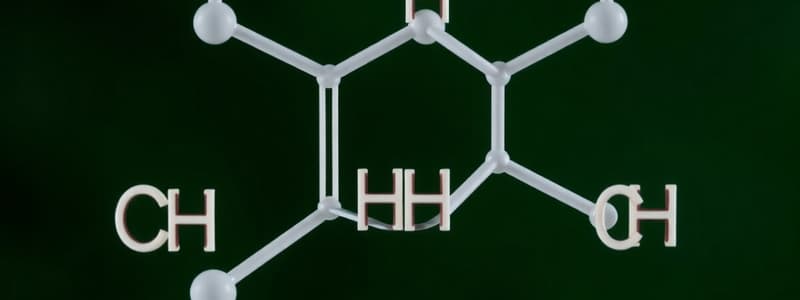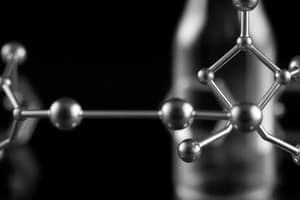Podcast
Questions and Answers
Which of the following structural features is necessary for a molecule to exhibit cis-trans isomerism?
Which of the following structural features is necessary for a molecule to exhibit cis-trans isomerism?
- Restricted rotation around a bond. (correct)
- Presence of a chiral center.
- At least one sp3 hybridized carbon atom.
- Presence of a carbon-carbon single bond.
Which type of isomer is Z-2-pentene?
Which type of isomer is Z-2-pentene?
- A geometric isomer. (correct)
- An optical isomer.
- A conformational isomer.
- A constitutional isomer.
According to Cahn-Ingold-Prelog (CIP) rules, what is the first criterion to consider when assigning priority to substituents on an alkene carbon?
According to Cahn-Ingold-Prelog (CIP) rules, what is the first criterion to consider when assigning priority to substituents on an alkene carbon?
- The complexity of the substituent.
- The size of the substituent.
- The number of hydrogen atoms attached to the substituent.
- The atomic mass of the directly attached atom. (correct)
In which scenario would the E,Z nomenclature be most necessary over the cis,trans nomenclature?
In which scenario would the E,Z nomenclature be most necessary over the cis,trans nomenclature?
If a carbon atom is double-bonded to another carbon atom, how is the double-bonded carbon treated when applying the Cahn-Ingold-Prelog priority rules?
If a carbon atom is double-bonded to another carbon atom, how is the double-bonded carbon treated when applying the Cahn-Ingold-Prelog priority rules?
Which of the following cycloalkanes can exhibit cis-trans isomerism?
Which of the following cycloalkanes can exhibit cis-trans isomerism?
Consider a disubstituted cyclohexane. If both substituents are pointing 'up' relative to the plane of the ring, what is the stereochemical designation?
Consider a disubstituted cyclohexane. If both substituents are pointing 'up' relative to the plane of the ring, what is the stereochemical designation?
Why do cis isomers generally have higher boiling points than trans isomers?
Why do cis isomers generally have higher boiling points than trans isomers?
Which of the following substituents has the highest priority according to the Cahn-Ingold-Prelog rules?
Which of the following substituents has the highest priority according to the Cahn-Ingold-Prelog rules?
Which of the following best explains why cycloalkanes exhibit stereoisomerism?
Which of the following best explains why cycloalkanes exhibit stereoisomerism?
What is the relationship between geometric isomers?
What is the relationship between geometric isomers?
Applying the Cahn-Ingold-Prelog rules, which substituent has higher priority: -CH=O or -CH2OH?
Applying the Cahn-Ingold-Prelog rules, which substituent has higher priority: -CH=O or -CH2OH?
Which of the following molecules does NOT exhibit cis-trans isomerism?
Which of the following molecules does NOT exhibit cis-trans isomerism?
What is the correct IUPAC name for the following compound $(CH_3CH_2)_2C=CHCH_3$?
What is the correct IUPAC name for the following compound $(CH_3CH_2)_2C=CHCH_3$?
Which of the following is the correct designation for a molecule of 2-chloro-2-butene where the chlorine and the methyl group are on the same side of the double bond, and the ethyl group is the other substituent on the same carbon of the double bond as the methyl group?
Which of the following is the correct designation for a molecule of 2-chloro-2-butene where the chlorine and the methyl group are on the same side of the double bond, and the ethyl group is the other substituent on the same carbon of the double bond as the methyl group?
What is the correct name for a cyclic compound with a chlorine oriented 'up' and a methyl group oriented 'down'?
What is the correct name for a cyclic compound with a chlorine oriented 'up' and a methyl group oriented 'down'?
Which of the following alkenes exhibits geometric isomerism?
Which of the following alkenes exhibits geometric isomerism?
What property is generally higher for cis isomers compared to trans isomers?
What property is generally higher for cis isomers compared to trans isomers?
How are multiple-bonded atoms treated when applying the Cahn-Ingold-Prelog priority rules? Consider a carbon atom double-bonded to an oxygen atom (C=O).
How are multiple-bonded atoms treated when applying the Cahn-Ingold-Prelog priority rules? Consider a carbon atom double-bonded to an oxygen atom (C=O).
Which statement accurately reflects the criteria for cis/trans isomerism in alkenes?
Which statement accurately reflects the criteria for cis/trans isomerism in alkenes?
Which molecule has the E configuration?
Which molecule has the E configuration?
Which of these substituents would receive the HIGHEST priority according to the Cahn-Ingold-Prelog rules?
Which of these substituents would receive the HIGHEST priority according to the Cahn-Ingold-Prelog rules?
Which molecule exhibits the highest boiling point?
Which molecule exhibits the highest boiling point?
Why does cis-1,2-dimethylcyclopropane have has a higher boiling point than trans-1,2-dimethylcyclopropane?
Why does cis-1,2-dimethylcyclopropane have has a higher boiling point than trans-1,2-dimethylcyclopropane?
Which of these compounds has the highest priority?
Which of these compounds has the highest priority?
Flashcards
Configurational Isomers
Configurational Isomers
Isomers that differ in the spatial arrangement of atoms due to the presence of rigid structures or chiral centers.
Geometric Isomers
Geometric Isomers
Stereoisomers that arise due to the restricted rotation around a double bond or in cyclic systems.
Cis Isomers
Cis Isomers
Geometric isomers where substituents are on the same side of the double bond or ring.
Trans Isomers
Trans Isomers
Signup and view all the flashcards
Group Priority System
Group Priority System
Signup and view all the flashcards
"Z" Designation
"Z" Designation
Signup and view all the flashcards
"E" Designation
"E" Designation
Signup and view all the flashcards
Cahn-Ingold-Prelog Rules
Cahn-Ingold-Prelog Rules
Signup and view all the flashcards
CIP Rule #1
CIP Rule #1
Signup and view all the flashcards
CIP Rule #2
CIP Rule #2
Signup and view all the flashcards
CIP Rule #3
CIP Rule #3
Signup and view all the flashcards
Cycloalkane Stereoisomerism
Cycloalkane Stereoisomerism
Signup and view all the flashcards
Study Notes
- The focus is on applying nomenclature rules for geometric isomers in organic chemistry.
Configurational Isomers
- Isomers are categorized into constitutional isomers and stereoisomers.
- Stereoisomers are further divided into configurational and conformational isomers.
- Configurational isomers include geometric and optical isomers.
- Geometric isomers include alkenes and disubstituted cycloalkanes.
- Optical isomers are divided into enantiomers and diastereomers.
Geometric Isomers: Cis-Trans Isomers
- Geometric isomers occur in alkenes and disubstituted cycloalkanes.
- Alkenes must have each carbon connected to two different groups to exhibit cis-trans isomerism.
- Cis isomers have similar groups on the same side.
- Trans isomers have similar groups on opposite sides.
E/Z System for Alkenes
- A priority system is needed for alkenes with non-hydrogen groups to define stereoisomers.
- Use the priority system to label alkenes as either E or Z.
- Z is analogous to cis (zusammen).
- E is analogous to trans (entgegen).
Cahn-Ingold-Prelog Sequence Rules
- Rule 1: Look at the first connected atom. A higher atomic number indicates higher priority.
- Bromine (atomic number 35) has more priority than chlorine (atomic number 17).
- -NO₂ has more priority than -COOH because nitrogen (atomic number 7) has more priority than carbon (atomic number 6).
- Rule 2: If the first atoms are identical, proceed to the second, third, or fourth atoms to assign priority.
- -CH₂CH₃ has more priority than -CH₃ (C-C versus C-H).
- -CH₂OH has more priority than -CH₂CH₃ (C-O versus C-C, where oxygen = 8, carbon = 6).
- Rule 3: Multiple-bonded atoms are treated as equivalent to the same number of single-bonded atoms.
- -C=O has more priority than –CH₂OH.
- -COOH has more priority than -CH=O.
- The more oxidized the carbon atom, the higher its priority.
Examples of E/Z Nomenclature
- Z-1-bromo-1-chloro-2-fluoro-2-iodoethene has the higher priority groups (Br and I) on the same side, hence the Z designation.
- E-1,2-dichloropropene has the higher priority groups on opposite sides, hence the E designation. -Z-1,2-dichloropropene has the higher priority groups on the same sides, thus the Z designation.
Cycloalkane Stereoisomers
- Isomerism occurs due to restricted rotation around C-C bonds in cyclic alkanes.
- Methyl groups are fixed above or below the ring plane.
- Cis-1,2-dimethylcyclopropane (boiling point 37°C) allows closer molecular contact from the H atom side, leading to higher London Dispersion Forces and boiling point.
- Trans-1,2-dimethylcyclopropane (boiling point 29°C) has -CH₃ groups on both sides, hindering close approach and lowering the boiling point compared to the cis isomer.
- Cis isomers have substituents on the same side.
- Trans isomers have substituents on opposite sides.
Summary Points
- Configurational isomers, also known as geometric isomers, exhibit distinct three-dimensional atomic arrangements.
- Alkenes need at least one H atom connected to one alkene C atom to potentially have cis or trans isomerism.
- The two H atoms are on the same side in cis isomers.
- The two H atoms are on opposite sides in trans isomers.
- Cycloalkanes: if two substituents are on the same side of the ring, it’s a cis cycloalkane; if on opposite sides, it’s trans.
- If an alkene doesn't have H atoms attached on both alkene C atoms, assign priorities to connected groups following the Cahn-Ingold-Prelog rules to name the groups as Z or E.
- Assign more priority to atoms with higher atomic numbers.
- Boiling points are impacted by the type of stereoisomer
- Cis isomers typically allow for closer contact, which will have higher boiling points than trans isomers of both alkenes and cycloalkanes
Studying That Suits You
Use AI to generate personalized quizzes and flashcards to suit your learning preferences.




